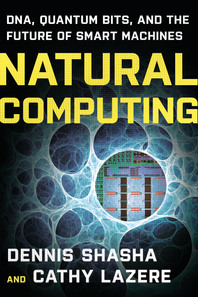
Natural Computing
DNA, Quantum Bits, and the Future of Smart Machines
2 July 2010
Territory Rights — Worldwide.
Description
Reports from the cutting edge, where physics and biology are changing the fundamental assumptions of computing.
Reviews
"The biographies, by Dennis Shasha and Cathy Lazere, are bite-size—no more than six pages or so—and the technical material is segregated in sidebars so that the reader doesn't get bogged down unless he or she wants to." — Washington Post
"In Natural Computing, Dennis Shasha and Cathy Lazere profile Mr. Shaw and 14 other scientists who are pushing computer science beyond traditional boundaries. In particular, the scientists are trespassing into the realms of biology and physics and attempting to create computer designs and functions that will imitate organic reality." — Jamie Hamilton, Wall Street Journal
"[A] breezy overview of current trends in computer design and software.... Amateur tech enthusiasts should be absorbed by this knowledgeable but welcoming look at the bleeding edge of computing." — Publishers Weekly
"Dennis Shasha and Cathy Lazere draw upon interviews with 15 leading scientists working in disparate fields to explore the outer reaches of computing. They expected to write a book about a future world dominated by thinking machines, but instead found that the common vision to have emerged across all of these fields is that "the future of computing is a synthesis with nature.".... Reading the book, I came away with the comforting thought that the mindset of future computers will seem far less alien to my kids than to me." — Thomas P.M. Barnett, World Politics Review
"There are many possible approaches to natural computing--computing inspired by nature--and Lazere and Shasha's new book gives a good overview of all of them… by telling the stories of some of the main players in the field.… even if you aren't a techie, the personal storytelling, which so nicely combines the technical focus of the book with the personal fascinations of the players, will still impress you with the natural computing field's main themes and challenges.… The authors also make the convincing case for parallel programming languages, such as K and APL, which seem indispensable when it comes to making effective use of the new generation of computer architectures." — Jan Van Den Bussche, ACM Computing Reviews
"[D]oes much to demystify what computer scientists do as well as reviewing the current state of research in the field. It’s the sort of book that’s perfect for a college student thinking about a career in computer science, or trying to understand which academic advisors to pick for his or her thesis." — Alexander Haislip, author of Essentials of Venture Capital
"In their book Natural Computing, Dennis Shasha and Cathy Lazere describe the calculations necessary for the analysis of protein folding, which is important in biological research and particularly in drug design. Time must be divided into very short intervals of around one femtosecond, which is a million billionth of a second, and for each interval, the interactions of all the atoms involved in the process must be calculated. Then do it again for the next femtosecond, and the next, and the next.… It is sobering to think about what vast computational resources are necessary to even begin to simulate what tiny bits of nature do all the time." — David Foster, Chicago Boyz blog






